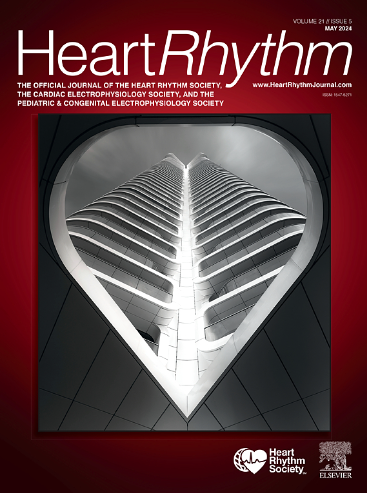Intracardiac vs transesophageal echocardiography for left atrial appendage occlusion: An updated systematic review and meta-analysis
IF 5.6
2区 医学
Q1 CARDIAC & CARDIOVASCULAR SYSTEMS
引用次数: 0
Abstract
Background
Multiple studies continue to evaluate the use of intracardiac echocardiography (ICE) and transesophageal echocardiography (TEE) for guiding left atrial appendage occlusion (LAAO).
Objective
The purpose of this study was to conduct an updated meta-analysis comparing the effectiveness and safety outcomes of both imaging modalities.
Methods
PubMed, Cochrane, and Embase were searched for studies comparing ICE vs TEE to guide LAAO. Odds ratios (ORs) with 95% confidence intervals (CIs) were pooled using a random-effects model. The primary effectiveness endpoint was procedural success. The primary safety endpoint included the overall complications rate. Additional safety outcomes were assessed as secondary endpoints. Subgroup analysis of primary endpoints was conducted according to device type (Amulet, LAmbre, Watchman, Watchman FLX) and study region (American, Asia, Europe). R Version 4.3.1 was used for all statistical analyses.
Results
Our meta-analysis included 19 observational studies encompassing 42,474 patients, of whom 4415 (10.4%) underwent ICE-guided LAAO. Compared with TEE, ICE was associated with a marginally higher procedural success (OR 1.33; 95% CI 1.01–1.76; P = .04; I2 = 0%). There was no significant difference in the overall complications rate (OR 1.02; 95% CI 0.77–1.36; P = .89; I2 = 5%). However, ICE showed higher rates of pericardial effusion (OR 2.11; 95% CI 1.47–3.03; P <.001; I2 = 0%) and residual iatrogenic atrial septal defect (iASD) (OR 1.52; 95% CI 1.15–2.03; P <.004; I2 = 0%). Subgroup analysis revealed variations in procedural success within the ICE group across study regions (P = .02).
Conclusion
In this updated meta-analysis, the increasing adoption of ICE-guided LAAO demonstrated higher procedural success rates compared to TEE, although with limited statistical significance. Overall complication rates were similar; however, ICE showed higher rates of pericardial effusion and residual iASD.
左房阑尾闭塞的心内超声心动图与经食道超声心动图:最新系统回顾和元分析。
背景:多项研究继续评估使用心内超声心动图(ICE)和经食道超声心动图(TEE)指导左房阑尾封堵术(LAAO)的效果:对两种成像模式的有效性和安全性进行最新的荟萃分析:方法:在PubMed、Cochrane和Embase中检索比较ICE与TEE引导LAAO的研究。采用随机效应模型对带有 95% 置信区间 (CI) 的比值比 (OR) 进行了汇总。主要有效性终点是手术成功率。主要安全性终点包括总体并发症发生率。其他安全性结果作为次要终点进行评估。根据设备类型(Amulet、LAmbre、Watchman、Watchman FLX)和研究地区(美国、亚洲、欧洲)对主要终点进行了分组分析。我们使用 R 4.3.1 版本进行所有统计分析:我们的荟萃分析纳入了 19 项观察性研究,涵盖 42,474 名患者,其中 4,415 人(10.4%)接受了 ICE 引导下的 LAAO。与 TEE 相比,ICE 与稍高的手术成功率相关(OR 1.33;95% CI:1.01-1.76;P=0.04;I2=0%)。总体并发症发生率无明显差异(OR 1.02;95% CI:0.77-1.36;P=0.89;I2=5%)。然而,ICE显示心包积液(OR 2.11;95% CI:1.47-3.03;P2=0%)和残留先天性房间隔缺损(iASD)(OR 1.52;95% CI:1.15-2.03;P2=0%)的发生率较高。亚组分析显示,不同研究地区ICE组的手术成功率存在差异(P=0.02):在这项更新的荟萃分析中,与 TEE 相比,ICE 引导下 LAAO 的采用率越来越高,显示出更高的手术成功率,尽管统计学意义有限。总体并发症发生率相似;但 ICE 显示心包积液和残留 iASD 的发生率更高。
本文章由计算机程序翻译,如有差异,请以英文原文为准。
求助全文
约1分钟内获得全文
求助全文
来源期刊

Heart rhythm
医学-心血管系统
CiteScore
10.50
自引率
5.50%
发文量
1465
审稿时长
24 days
期刊介绍:
HeartRhythm, the official Journal of the Heart Rhythm Society and the Cardiac Electrophysiology Society, is a unique journal for fundamental discovery and clinical applicability.
HeartRhythm integrates the entire cardiac electrophysiology (EP) community from basic and clinical academic researchers, private practitioners, engineers, allied professionals, industry, and trainees, all of whom are vital and interdependent members of our EP community.
The Heart Rhythm Society is the international leader in science, education, and advocacy for cardiac arrhythmia professionals and patients, and the primary information resource on heart rhythm disorders. Its mission is to improve the care of patients by promoting research, education, and optimal health care policies and standards.
 求助内容:
求助内容: 应助结果提醒方式:
应助结果提醒方式:


